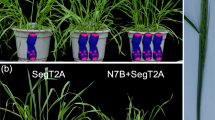Eight fourth chromosomes which were homozygous lethal and 170 which were homozygous nonlethal were extracted from the same Drosophila melanogaster cage. The lethals were complementary, i.e., they were viable in all 28 nonreflexive pairwise combinations. Three different lethals produced sterile homozygotes; these are called leaky lethals. Different lethal heterozygotes' viabilities were compared by means of paired-t tests. The difference in mean relative viabilities between a pair of genotypes containing different lethals but exactly the same nonlethal was treated as one observation. The mean difference for any pair of lethals was based on only part of the full array of nonlethals. Of 17 possible paired comparisons, nine were statistically significant. In eight out of ten possible pairs and in six out of seven significant pairs, the heterozygous viability of leaky lethals was less than that of absolute (nonleaky) lethals. There was no association between stage of homozygous lethal action and heterozygous viability effect. In general, different lethals had different heterozygous effects on viability. The results are summarized in Table 5.
Similar content being viewed by others
References
Anderson, W. W. (1969). Genetics of natural populations. XLI: The selection coefficients of heterozygotes for lethal chromosomes in Drosophila on different genetic backgrounds. Genetics 62: 827–836.
Crow, J. F. (1968). Some analyses of hidden variability in Drosophila populations. In: R. C. Lewontin, Ed., Population Biology and Evolution, pp. 71–86. Syracuse Univ. Press, Syracuse, New York.
Crow, J. F. (1970). Genetic loads and the cost of natural selection. In: K. I. Kojima, Ed., Mathematical Topics in Population Genetics, pp. 128–177. Springer, Heidelberg.
Crow, J. F. & Temin, R. G. (1964). Evidence for the partial dominance of recessive lethal genes in natural populations of Drosophila. Am. Nat. 98: 21–33.
Dobzhanzky, Th. (1964). How do the genetic loads affect the fitness of their carriers in Drosophila populations? Am. Nat. 98: 151–166.
Hiraizumi, Y. & Crow, J. F. (1960). Heterozygous effects on viability, fertility, rate of development, and longevity of Drosophila chromosomes that are lethal when homozygous. Genetics 45: 1071–1083.
Hochman, B. (1968). The developmental time of action of recessive lethal mutations on the fourth chromosome of Drosophila melanogaster. (Abstract) Proc. XIIth. Int. Congr. Genet. 1: 147.
Hochman, B. (1971). Analysis of chromosome 4 in Drosophila melanogaster. II: Ethyl methanesulfonate induced lethals. Genetics 67: 235–252.
Hoenigsbero, H. F. (1968). Rate of elimination of natural lethals. Am. Nat. 102: 185–187.
Kenyon, A. (1967). Comparison of frequency distributions of viabilities of second with fourth chromosomes rom caged Drosophila melanogaster. Genetics 55: 123–130.
Kitagawa, O. (1967). Interaction in fitness between lethal genes in heterozygous condition in Drosophila melanogaster. Genetics 57: 809–820.
Levins, R. (1967). Theory of fitness in a heterogeneous environment. VI: The adaptive significance of mutation. Genetics 56: 163–178.
Lewontin, R. C. (1967). Population genetics, Ann. Rev. Genet. 1: 37–70.
Lewontin, R. C. & Prout, T. (1956). Estimation of the number of different classes in a population. Biometrics 12: 211–223.
Magalhães, L. E., A. B.Da Cunha, J. S.de Toledo, S.A. Toledo F°, H.L.de Souza, H. J. Targa, V. Setzer, & C. Pavan (1965). On lethals and their suppressors in experimental populations of Drosophia willistoni. Mutat. Res. 2: 45–54.
Moree, R. (1968). Selection for and against heterozygous lethals in American populations of Drosophila melanogaster. Dros. Int. Serv. 43: 153.
Morton, N. E., C. S. Chung, & L. D. Friedman (1968). Relation between homozygous viability and average dominance in Drosophila melanogaster. Genetics 60: 601–614.
Murata, M. (1970). Frequency distribution of lethal chremosomes in small populations of Drosophila melanogaster. Genetics 64: 559–571.
Prout, T. (1967). Theory of the allelism between different Drosophila lethals collected at different times. Genetics 56: 659–666.
Seto, F. (1954a). The relation between time of death of lethal homozygotes and viability of heterozygotes in Drosophila, Am. Nat. 88: 373–378.
Seto, F. (1954b). Time of action of a series of recessive lethal factors in Drosophila melanogaster. J. Exp. Zool. 126: 17–32.
Seto, F. (1961). A developmental study of recessive lethals from wild populations of Drosophila melanogaster. Am. Nat. 95: 365–373.
Temin, R. G., H. U. Mever, P. S. Dawson & J. F. Crow (1969). The influence of epistasis on homozygous viability depression in Drosophila melanogaster. Genetics 61: 497–519.
Vann, E. (1970). The effects of various homologous chromosomes on the viability of Drosophila melanogaster lethal heterozygotes. Am. Nat. 104: 401–404.
Wallace, B. (1966). Distance and the allelism of lethals in a tropical population of Drosophila melanogaster. Am. Nat. 100: 565–578.
Wallace, B. (1968). Topics in Population Genetics. Norton, New York.
Warren, K. B., R. L. Klein, C. V. Madden & G. R. Reiter (1952). The time of action of lethals of different origins in Drosophila melanogaster, Dros. Int. Serv. 26: 126.
Wright, T. R. F. (1970). The genetics of embryogenesis in Drosophila. Adv. Genet. 15: 261–395.
Author information
Authors and Affiliations
Additional information
In memoriam David Walter Kenyon (1939–1972)
Research supported by The National Science Foundation of the United States (GB-3759).
Rights and permissions
About this article
Cite this article
Kenvon, A. Heterozygous effects on viability of Drosophila supergenes that are lethal when homozygous. Genetica 43, 536–551 (1972). https://doi.org/10.1007/BF00115597
Received:
Accepted:
Issue Date:
DOI: https://doi.org/10.1007/BF00115597




